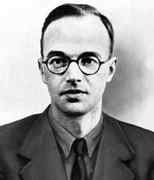
Klaus Fuchs was a German theoretical physicist best known as an atomic spy who supplied information to the Soviet Union.
Born in 1938, The Statistical Mechanics of Condensing Systems. * Fuchs was a German citizen so he was interned, first at a camp on the Isle of Man then from June to December 1940 he was held in Quebec, Canada. * High quality papers by Fuchs continued to be published through 1940, one single author paper On the Statistical Method in Nuclear Theory, and four papers written jointly with Max Born (1) The Mass Centre in Relativity, (2) Reciprocity, Part II: Scalar Wave Functions, (3) Reciprocity, Part III: Reciprocal Wave Functions, and (4) Reciprocity, Part IV: Spinor Wave Functions. * Born was deeply impressed by Fuchs' abilities which he bracketed with those of his student Werner Heisenberg. * He wanted Fuchs back to continue their collaboration and made requests for him to be released from internment. * These requests were successful in December 1940 and Fuchs returned to Edinburgh. * But Fuchs thought otherwise. * Fuchs made application for British citizenship and his application was signed by Edward Copson. * This was quickly accepted, Fuchs signed the Official Secrets Act and began work with Peierls in Birmingham before the end of 1941. * Although Fuchs clearly breached the Official Secrets Act in passing information to the Russians, one should also note that Britain and Russia were allies with a treaty to require both sides to share military secrets with the other. * In August 1943 the Quebec Conference set up a formal collaboration between Britain and the United States on nuclear weapons research and, after a fact finding mission by Peierls in Washington, the key British researchers including Fuchs, joined the Manhattan Project. * It is still somewhat difficult, because of the secrecy surrounding the project, to evaluate Fuchs' contribution precisely but there is no doubt that it was one of the most significant. * In 1946 Fuchs and von Neumann applied for a patent for the trigger for the ignition of the bomb. * In January 1950 Fuchs was interrogated by MI5 officer William Skardon. * Although Skardon did not have sufficient evidence against Fuchs to convict him of an offence, nevertheless he persuaded Fuchs to make a full confession which he did on 23 January. * A week later Russia issued a statement denying that Fuchs had spied for them - they certainly did not want any of the merit attached to their own achievements in developing nuclear weapons to be seen to be due to British or American expertise. * Fuchs married Grete Keilson in 1959. * We look briefly at some of the more mathematical papers published by Fuchs after he resumed his research in East Germany. * Fuchs seldom spoke of his spying activities during his years in East Germany.
Born in 1938, The Statistical Mechanics of Condensing Systems. * Fuchs was a German citizen so he was interned, first at a camp on the Isle of Man then from June to December 1940 he was held in Quebec, Canada. * High quality papers by Fuchs continued to be published through 1940, one single author paper On the Statistical Method in Nuclear Theory, and four papers written jointly with Max Born (1) The Mass Centre in Relativity, (2) Reciprocity, Part II: Scalar Wave Functions, (3) Reciprocity, Part III: Reciprocal Wave Functions, and (4) Reciprocity, Part IV: Spinor Wave Functions. * Born was deeply impressed by Fuchs' abilities which he bracketed with those of his student Werner Heisenberg. * He wanted Fuchs back to continue their collaboration and made requests for him to be released from internment. * These requests were successful in December 1940 and Fuchs returned to Edinburgh. * But Fuchs thought otherwise. * Fuchs made application for British citizenship and his application was signed by Edward Copson. * This was quickly accepted, Fuchs signed the Official Secrets Act and began work with Peierls in Birmingham before the end of 1941. * Although Fuchs clearly breached the Official Secrets Act in passing information to the Russians, one should also note that Britain and Russia were allies with a treaty to require both sides to share military secrets with the other. * In August 1943 the Quebec Conference set up a formal collaboration between Britain and the United States on nuclear weapons research and, after a fact finding mission by Peierls in Washington, the key British researchers including Fuchs, joined the Manhattan Project. * It is still somewhat difficult, because of the secrecy surrounding the project, to evaluate Fuchs' contribution precisely but there is no doubt that it was one of the most significant. * In 1946 Fuchs and von Neumann applied for a patent for the trigger for the ignition of the bomb. * In January 1950 Fuchs was interrogated by MI5 officer William Skardon. * Although Skardon did not have sufficient evidence against Fuchs to convict him of an offence, nevertheless he persuaded Fuchs to make a full confession which he did on 23 January. * A week later Russia issued a statement denying that Fuchs had spied for them - they certainly did not want any of the merit attached to their own achievements in developing nuclear weapons to be seen to be due to British or American expertise. * Fuchs married Grete Keilson in 1959. * We look briefly at some of the more mathematical papers published by Fuchs after he resumed his research in East Germany. * Fuchs seldom spoke of his spying activities during his years in East Germany.
Born 29 December 1911, Rüsselsheim, Germany. Died 28 January 1988, Dresden, East Germany.
View full biography at MacTutor
Origin Germany